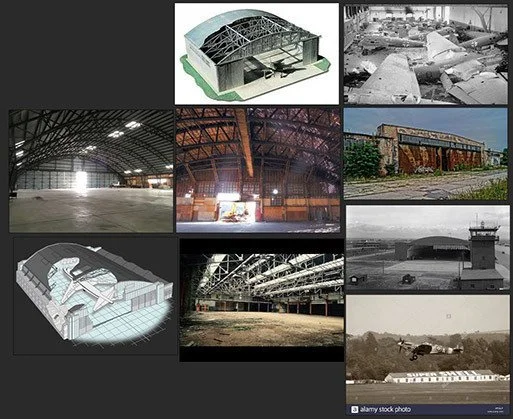Group Spitifre Project
The other project that I had to work on for the first semester in the second year was a Group project where we would be working with a client to fulfil a brief.
The project that I chose to work on was the “Making of the Spitfire” project. This project would be used to as an educational tool to help teach people about the people who made the legendary spitfire.
Because this is a group project, we would have to keep a constant channel of communication open with David Key. David is in charge of the Supermariners Website and knows a lot about the spitfire that we would be using as our basis for this project. David was responsible for setting out the brief and ensuring that the ideas that we came up with would fit his brief suitably.
I planned to have the hangar how it would be seen these days. Things like the floor cracking, rusted metal and modern tools. This can all be seen in the drawings that I came up with. There are wings propped up against the wall, and propellers hung up ready to be used. The plane itself would be in the middle of the hangar. My drawings had that on a podium but that could still change by the final model.
Research and Refrences
Once I had this planned out, I started looking for some reference images. Using the program, pureRef, I gathered some picture of hangars, both how they are now, but how how they would have looked at the time. This would allow me to plan out my hangar to include all the key aspects that I would research from the images. From these image, I was able to gain a few bit of key design choices present in most of the images. Some of these design choices included things like the Curved Corrugated roof, the beams running across the width of the roof and the Corrugated walls going up to the roof.
This was a draft that was made after a couple of itterations.
the first thing I made was the propellers that would go on one of the walls. To make them, I just used cylinders that were shrunk down on one side and then had parts of them extruded to make the blades. I also made some wings that could be lent up against the wall ready to be used. Because the wings are such a identifiable part of the plane, I used reference images while making them. These would allow me to ensure that my version would look the same, ensuring that the wings would look correct and that anyone looking at the scene would be able to tell that they came from the Spitfire. It was after making these and placing them in the environment that I decided that the original size of the hanger was to long and would take a lot of elements to fill up. And since this would be a web-based application, The poly count needs to be quite low.
This is the final hangar with the new plane inside it. The total for the whole hangar is 324’326 faces. This includes the plane and all the parts around the hangar. Unfortunately, this is as low as I could get the face count due to having to keep the spitfire a high poly count to keep the detail that it needed to look realistic so that it can be used as a learning tool as intended. However, it will still be low enough that it will run without issues on a website.




